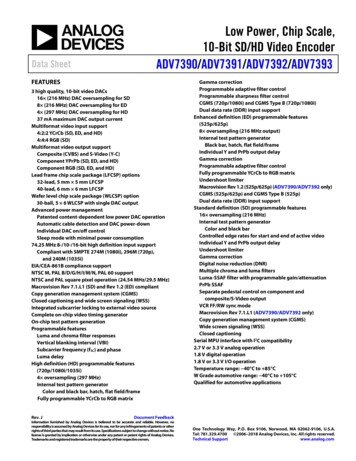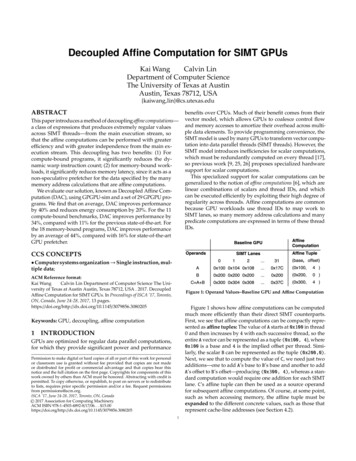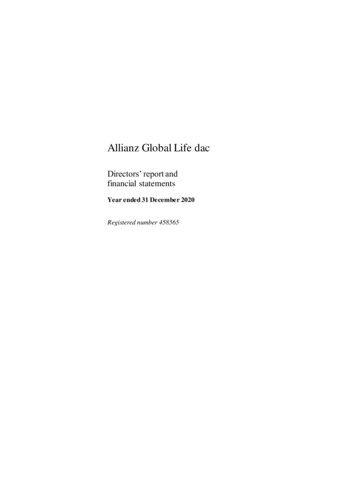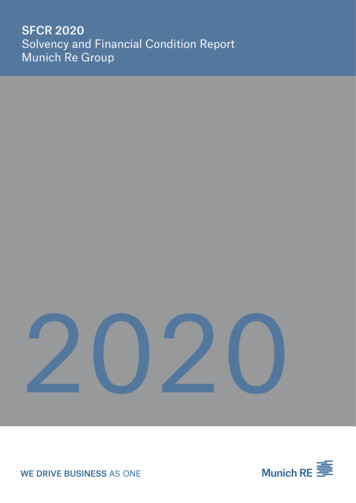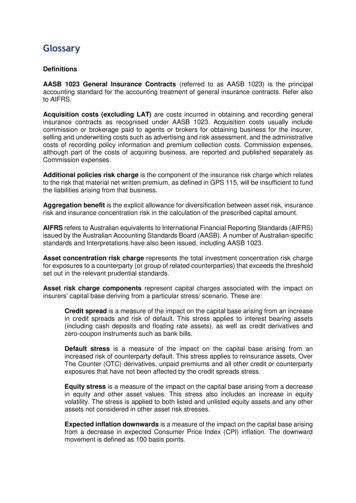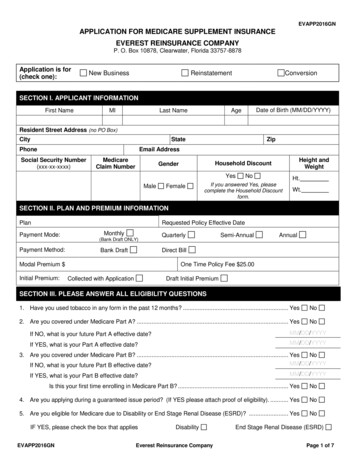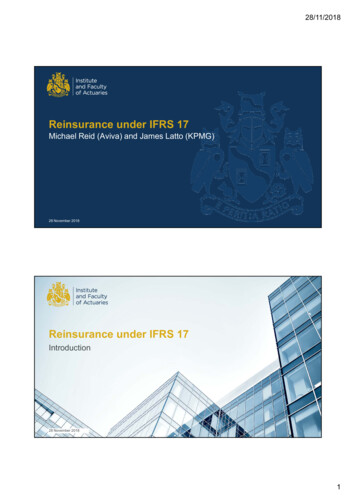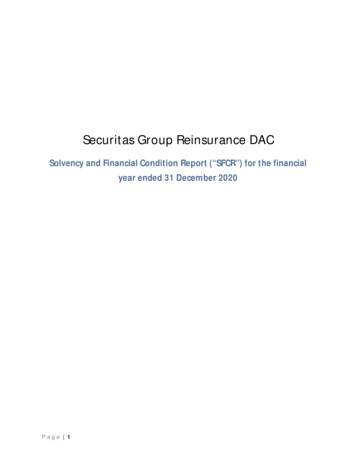
Transcription
Securitas Group Reinsurance DACSolvency and Financial Condition Report (“SFCR”) for the financialyear ended 31 December 2020P age 1
ContentsEXECUTIVE SUMMARY. 4BUSINESS AND PERFORMANCE. 6AA.1A.2A.3A.4A.5BUSINESS . 6UNDERWRITING PERFORMANCE . 7INVESTMENT PERFORMANCE. 9PERFORMANCE OF OTHER ACTIVITIES . 10ANY OTHER INFORMATION . 10SYSTEM OF GOVERNANCE . 11BB.1B.2B.3GENERAL INFORMATION ON THE SYSTEM OF GOVERNANCE . 11FIT AND PROPER REQUIREMENTS. 13RISK MANAGEMENT SYSTEM INCLUDING THE OWN RISK AND SOLVENCY . 14ASSESSMENT . 14B.4 INTERNAL CONTROL SYSTEM . 19B.5 INTERNAL AUDIT FUNCTION . 20B.6 ACTUARIAL FUNCTION . 21B.7 OUTSOURCING . 21B.8 ASSESSMENT OF THE ADEQUACY OF THE SYSTEM OF GOVERNANCE OF THE INSURANCE . 22OR REINSURANCE UNDERTAKING TO THE NATURE, SCALE AND COMPLEXITY OF THE RISKS . 22B.9 ANY OTHER MATERIAL INFORMATION REGARDING THE SYSTEM OF GOVERNANCE OF . 22THE COMPANY . 22RISK PROFILE. 23CC.1C.2C.3C.4C.5C.6C.7UNDERWRITING RISK . 23MARKET RISK . 24CREDIT RISK . 26LIQUIDITY RISK . 27OPERATIONAL RISK . 27OTHER MATERIAL RISKS . 28AMOUNT OF EXPECTED PROFIT INCLUDED IN FUTURE PREMIUMS AS CALCULATED IN . 29ACCORDANCE WITH ARTICLE 260(2) . 29AN ADJUSTMENT OF USD 1.5M HAS BEEN MADE TO THE TECHNICAL PROVISIONS IN RELATION TO EXPECTEDPROFIT INCLUDED IN FUTURE PREMIUMS. . 29C.8 STRESS AND SENSITIVITY TESTS . 29C.9 ANY OTHER INFORMATION . 29DVALUATION FOR SOLVENCY PURPOSES. 30D.1 ASSETS . 30D.2 TECHNICAL PROVISIONS . 31D.3 OTHER LIABILITIES . 33D.4 ALTERNATIVE METHODS FOR VALUATION FOR OTHER LIABILITIES . 33D.5 ANY OTHER INFORMATION . 33ECAPITAL MANAGEMENT . 35P age 2
E.1 OWN FUNDS . 35E.2 SOLVENCY CAPITAL REQUIREMENT AND MINIMUM CAPITAL REQUIREMENT . 37E.3 ANY USE OF THE EQUITY RISK SUB-MODULE IN THE CALCULATION OF THE SOLVENCY . 38CAPITAL REQUIREMENT. . 38E.4 INTERNAL MODEL INFORMATION. . 38E.5 NON COMPLIANCE WITH THE MINIMUM CAPITAL REQUIREMENT AND SIGNIFICANT . 39NON-COMPLIANCE WITH THE SOLVENCY CAPITAL REQUIREMENT. 39E.6 ANY OTHER INFORMATION . 39P age 3
Executive SummaryCompany BackgroundSecuritas Group Reinsurance dac is a company incorporated in Ireland and authorised by the Central Bankof Ireland to carry out the following classes of non-life reinsurance business:··Motor Vehicle Liability;Workers’ Compensation, Employers’ Liability and General Liability.The Company is a non-life reinsurance captive whose principal activity is the undertaking of reinsurancebusiness in respect of the General Liability, Workers Compensation, Auto Liability and Employers Liabilityrisks of the Securitas group.Business and PerformanceThe Company’s financial year end is 31st December each year. The Company booked pre-tax profits ofUSD9.3 million in the year ended 31st December 2020 (2019: USD20.2 million). The profits have beendriven by a positive underwriting performance on the business written in the year. No dividend wasdeclared in 2020 (2019: USD13 million).System of GovernanceThe Company is subject to the the Central Bank of Ireland’s Corporate Governance Requirements forCaptive Insurance and Captive Reinsurance Undertakings 2015. The corporate governance principles ofthe Company are implemented via the following Corporate Governance Framework:······Board of DirectorsOutsourced Service ProvidersInternal Control FrameworkRisk Management FrameworkCompliance FunctionAudit – Internal & ExternalOutsourced ActivitiesThe following is a list of the important outsourced operational functions together with the jurisdiction in whichthe service providers of such functions or activities are located as of the submission date:Critical Outsourcing ArrangementsOutsourced ProviderMarsh Management Services(Dublin) LimitedOLIVER WYMANSecuritasP age 4Service OutsourcedCaptive ManagerCompliance FunctionRisk ManagementFunctionHead of ActuarialFunctionInternal Audit FunctionInternal/External JurisdictionExternalOutsourcingOversightEUChairman ( PCF-3)ExternalUSInternalUS
Risk ProfileThe following table outlines the material risks to which the Company is exposed as well as the undiversifiedcapital charge associated with the risks.Capital Charge USD’000202050,103116,07320,720RiskMarket RiskCounterparty DefaultNon-Life UnderwritingHealthCapital Charge USD’000201928,9776315,36820,184These risks are covered in further detail in Section C of this report.Valuation for Solvency PurposesThe Company assets and liabilities, under Solvency II methodology, are valued at best estimate. This differsin some respects from the GAAP valuations for financial statements. In particular, the technical provisionsfor the Solvency II balance sheet represent the present value of future claim payments. A risk margin isalso included in technical provisions, which represents the cost of holding the solvency capital requirement.Section D of the SFCR shows the comparison between the Solvency II balance sheet and the FinancialStatements.Capital ManagementThe objective of own funds management is to maintain, at all times, sufficient own funds to cover the SCRand MCR with an appropriate buffer. As part of own funds management, the Company prepares ongoingannual solvency projections and reviews the structure of own funds and future requirements. The businessplan, which forms the basis of the ORSA contains a three year projection of funding requirements and helpsfocus actions for future funding.The Company is a single shareholder entity whose ordinary shares are fully paid up. It has no debt financingnor does it have plans to raise debt or issue new shares capital over the three year time horizon used forbusiness planning.The company solvency position including the individual risks is as follows:Solvency2020 Capital 19 Capital requirementUSDSCRMCRP age 547,510,62712,816,4492020 EligiblecapitalUSD79,033,19578,774,2922019 EligiblecapitalUSD81,764,70581,764,7052020 Solvencyratio118%469%2019 Solvencyratio172%638%
AA.1A.1.1BUSINESS and PERFORMANCEBusinessName and legal form of the undertakingSecuritas Group Reinsurance DAC (hereinafter “the Company”) is incorporated in the Republic ofIreland and is a private company limited by shares.A.1.2Name of the Supervisory Authority responsible for the financial supervision of the undertakingThe Company is regulated by the Central Bank of Ireland (CBI). The CBI can be contacted at:Central Bank of Ireland, PO BOX 559, New Wapping Street, North Wall Quay, Dublin 1, Ireland.A.1.3External auditor of the undertakingThe independent auditors of the Company are:PricewaterhouseCoopers, Chartered Accountants and Statutory Audit Firm, One Spencer Dock,North Wall Quay. Dublin 1, Ireland.A.1.4Holders of Qualifying Holdings in the UndertakingThe Company is wholly owned by Securitas AB., a company incorporated in Sweden.A.1.5Legal Structure of the GroupSecuritas AB is also the ultimate parent company.A.1.6Material lines of business and geographical areasThe Company is a non-life reinsurance captive whose principal activity is the undertaking ofreinsurance business in respect of the General Liability, Workers Compensation, Auto Liabilityand Employers Liability risks of the Securitas group.The material geographical areas in which the Company operates are the European EconomicArea (“EEA”) and the United States.P age 6
A.1.7Significant Business events during the reporting periodThe Company is closely monitoring developments relating to the COVID-19 pandemic. TheCompany has deployed business continuity plans to ensure that the business continues tooperate. The Directors have reviewed the composition of its assets at the balance sheet dateand believe that the Company has sufficient liquid assets to meet its liabilities at the balancesheet date as they fall due. Furthermore, the Directors have also assessed the security andrecoverability of the Company’s assets and, over the next twelve months, they consider thatthey are not at risk.At the time of signing the financial statements, the impact of COVID-19 continues to evolve, butthe Company will continue to monitor developments and respond as appropriate. The Directorshave also reviewed the potential impact of COVID-19 on the Company’s underwritingperformance and at the date of approval of the financial statements and over the period ofassessment, the Directors are satisfied that Company’s estimated solvency ratio under SolvencyII remains within the Company’s risk appetite range.A.2Underwriting PerformanceThe premium income written by the Company was derived from the coverage of the non-lifereinsurance risks of the Securitas group.The Company writes the following lines of business: Workers’ Compensation, Employers’ Liabilityand General Liability and Motor Vehicle Liability. For the purposes of capital reporting these arecategorised as:Class of Business as Local GAAPWorkers’ CompensationEmployer’s LiabilityGeneral LiabilityMotor Vehicle LiabilitySolvency II Class of BusinessWorkers’ CompensationGeneral LiabilityGeneral LiabilityMotor Vehicle LiabilityThe Company has determined that the USD is the functional currency.The tables below show a summary of the technical (underwriting) account for the year ended 31December 2020 by material Line of Business and Geographical area (based on Irish GAAP):Underwriting performance for the main Solvency II Lines of Business and Geographical areas(including aggregate performance).P age 7
Aggregate UW (643)1,0808,428Written PremiumsEarned PremiumsClaims IncurredUnderwriting ExpensesAllocated Investment ReturnNet Technical 2,87818,011Financial Year Ended 31 December 2020Line of BusinessWritten PremiumsEarned PremiumsClaims IncurredUnderwritingExpensesAllocated InvestmentReturnNet Technical 14,992)(440)General LiabilityUSD’00010,92510,925(7,497)(176)Motor 3403,603(515)8,428Financial Year Ended 31 December 2020United StatesMaterial GeographicalLocationWritten PremiumsEarned PremiumsClaims IncurredUnderwritingExpensesAllocated InvestmentReturnNet Technical ResultP age 8USD’000Non- 643)1,043371,0807,9015278,428
Financial Year Ended 31 December 2019Line of BusinessWritten PremiumsEarned PremiumsClaims IncurredUnderwritingExpensesAllocatedInvestment ReturnNet Technical 10,269)(412)General LiabilityUSD’00010,92510,925(4,737)(144)Motor 811,1696,980(138)18,011Financial Year Ended 31 December 2019United StatesMaterialGeographicalLocationUSD’000Written PremiumsEarned PremiumsClaims IncurredUnderwritingExpensesAllocated InvestmentReturnNet Technical ResultA.3Non- 580)2,779992,87817,60041118,011Investment PerformanceA.3.1 Income and expenses arising by asset classThe Company has an investment strategy which complies with the requirements of “the prudentperson principle”.As at 31 December 2020 the Company’s investment portfolio comprised the following materialasset classes:P age 9
31/12/2020Asset ClassAmountUSD’00031/12/2019Cash at bank and in handIntercompany deposit10187,461% 181,501% ofportfolio0%100%181,518100%The table below sets out the investment returns by asset class:Asset Class31/12/202031/12/2019USD’000USD’000Cash and fixed depositsIntercompany deposit01,93315,020Total1,9335,021A.3.2 Gains and losses recognised directly in equityNo gains and losses have been recognised directly in equity.A.3.3 Investments in securitisationThere are no investments in securitisation.A.4Performance of Other ActivitiesA.4.1 There have been no other significant activities undertaken by the company other than itsreinsurance and related activities.A.5Any Other InformationThere are no other material matters in respect of the business and performance of the Company.P a g e 10
BSYSTEM of GOVERNANCEB.1General information on the system of governanceB.1.1Role and responsibilities of the administrative, management or supervisory body and keyfunctionsThe Company is classified as a Low Risk firm under the Central Bank of Ireland’s risk-basedframework for the supervision of regulated firms, known as PRISM or Probability Risk and ImpactSystem and is subject to the Central Bank of Ireland’s Corporate Governance Requirements forCaptive Insurance and Captive Reinsurance Undertakings 2015.Board of Directors:The Company’s Board of Directors carries responsibility for the effective, prudent and ethicaloversight of the business and set it business strategy and risk appetite. The Board of Directors isalso responsible for ensuring that risk and compliance are properly managed in the company.The directors of the Company during the year are listed below:S. Grace (Chairman)F. London - Resigned 1st October 2020M. Östman - Appointed 1st October 2020M.L. BjorkB. AdamIndependent Control Functions:The Company has established the four key control functions in line with Solvency II requirements:risk management, actuarial, compliance and internal audit. These functions, each possessingdistinct responsibilities, are tasked with providing oversight of and challenge to the business andfor providing assurance to the Board in relation to the Company’s control framework.Risk Management FunctionThe role of the Company’s risk management function is to identify and evaluate the major risksfacing The Company and to facilitate the implementation of the risk management system. Havingconsidered the nature scale and complexity of the Company the Board have determined that therole of the RMF can be carried out by the Captive Manager, Marsh Management Services(Dublin) Limited (“the Manager”) under the supervision of the Board.The roles and responsibilities of the risk management function are set out within the riskmanagement policy.P a g e 11
Compliance FunctionIn order to effectively monitor and report on The Company’s requirement to be in compliancewith all applicable laws and regulatory requirements the Board of Directors has outsourced thecompliance function to the Manager and an employee of the Manager has been appointed asCompliance Officer. The Compliance Officer reports to the Board.Actuarial FunctionTo ensure compliance with Solvency II obligations, the role of the Head of Actuarial Function(“HoAF”) is outsourced to a third party provider. The HoAF reports to the Board.Internal Audit FunctionSecuritas North America were newly appointed as Head of Internal Audit in January 2019. Thescope of internal audit activities includes the examination and evaluation of the effectiveness ofthe internal control, risk management and governance systems and processes of the entirelicensed entity, including the Company’s outsourced activities. The Internal Audit function reportsto the Board.B.1.2 Material changes in the system of governance that have taken place over the reporting period.NoneB.1.3 Remuneration policy for the administrative, management or supervisory body and employeesB.1.3.1 Remuneration policy for the administrative, management or supervisory body and employeesThe Company does not have any employees. Day to day running of the Company is handled bythe Manager under a third party administrative agreement.Hence the Company’s remuneration policy refers only to the remuneration of non-group executivedirectors should circumstances dictate that it is necessary to appoint external Executive Directorsto the Board.The Board of Directors of the Company includes Group Directors who are remunerated via theirservice agreements with Securitas AB.B.1.3.2 Material transactions during the reporting period with shareholders, with persons who exercise asignificant influence on the undertaking, and with members of the administrative, management orsupervisory bodyThe Company is a non-life reinsurance captive whose principal activity is the undertaking ofreinsurance business in respect of workers compensation, employers’ liability liability), generalliability and automobile liability risks of the Securitas group.The Company did not enter into any transactions with key management personnel in theSecuritas group during the year ended 31 December 2020.There is a credit agreement in place with Securitas AB. and the deposit balance to the Companyas at 31 December 2020 was USD 187.5m (2019: USD 181.5m).P a g e 12
The Company did not declare any dividend for 2020 (2019: USD 13.0 million) to the shareholderduring the year.B.2Fit and Proper requirementsB.2.1 Requirements for skills, knowledge and expertiseOn 1 October 2010, Part 3 of the Central Bank Reform Act 2010 introduced a harmonisedstatutory system for the regulation by the CBI of persons performing Controlled Functions (‘CFs’)and Pre-Approval Controlled Functions (‘PCFs’) in regulated financial service providers.On 1 December 2011 the CBI issued the Fitness & Probity Standards under Section 50 of theCentral Bank Reform Act 2010 which all persons performing Controlled Functions or PreApproval Controlled Functions should, at a minimum, comply with.Guidance for (Re)Insurance Undertakings on the Fitness & Probity Amendments 2015 furtherassist companies in complying with their obligations brought in by the Solvency II (EuropeanUnion (Insurance and Reinsurance) Regulations 2015 S.I. 485 of 2015).The Company has adopted a Fitness and Probity Policy (reviewed by the Board on an annualbasis) with the purpose of ensuring that:······persons holding key positions within the Company are assessed in terms of their fitnessand probity in relation to a proposed role and on an ongoing basis;effective procedures are in place to undertake this assessment;the results of such an assessment are documented;the Board is satisfied that it can conclude that persons holding key positions are fit andproper;responsibility is assigned to ensure fitness and probity is monitored on a continuousbasis;approval is sought from the Central Bank of Ireland (‘CBI’) prior to the appointment ofpersons performing Pre-Approval Control Functions.B.2.2 Process for assessing the fitness and the propriety of the persons who effectively run theundertaking or have other key functionsThe Policy outlines the procedures that must be followed for assessing the fitness and probity ofpersons performing CFs and PCFS while also stipulating the requirements for instances wheneither of these functions are outsourced to a regulated or unregulated entity.It also focuses on the documentation, controls and governance that are required to be in place toensure compliance with the abovementioned Regulations.This is achieved in the main by means of internal checklists, documentary evidence ofqualifications proving suitability for the role in question, references, regulatory authority,companies’ office and police authority checks and self-certifications from the applicant in the formof Curricula Vitae and the CBI Individual Questionnaires.P a g e 13
B.3Risk management system including the own risk and solvencyassessmentB.3.1 Risk management systemThe Company’s risk management system is set out as follows:1. The Board sets the Company Strategy.2. The Board sets the Risk Strategy. The Risk Strategy describes and addresses themanagement of all material risks that the Company is exposed to in pursuit of theCompany Strategy.3. The Board sets the Risk Appetite. The Risk Appetite sets out the desired level of risk andthe maximum level of variation from its risk appetite that it is willing to accept.4. The Board has approved a Risk Policy and other individual risk policies necessary for theimplementation of it Risk Strategy, consistent with its Risk Appetite.The Company uses the Standard Formula to assess the solvency and capital requirements.The Company performs an Own Risk and Solvency Assessment (“ORSA”) at least annually. Themain purpose of performing the ORSA is to ensure that the Company engages in a process ofassessing all risks inherent in the business and determining the corresponding capital needs.In order to ensure effective risk governance, the system has been designed to identify, assess,manage and monitor and report exposure to risk. This is a continuous process subject tocontinuous review and development.IdentifyThe board reviews the risk profile of the Company at least annually and the Risk ManagementFunction reviews the risk profile on an ongoing basis to ensure that the material risks of theCompany are identified and recorded in the risk register.AssessRisks identified in the risk register are then quantified by the Board with input from the RiskManagement Function and tolerances are established through the development of a risk appetitestatement.P a g e 14
ManageThe Board determines the minimum standards to be maintained by the Company in order tomanage the risks in a way that is consistent with its risk appetite by developing suitable individualrisk policies.Monitor/ReportMonitoring and reporting to the Board is undertaken at least quarterly from a number of sourcesincluding the Risk Management Function, Compliance Officer and the Internal Audit Function.Findings from the development of the risk register are considered by the Board in the preparationof the annual internal audit plans.The result is a risk management strategy, which is led by the Board of Directors whilst beingembedded in the Company’s business systems, strategy and policy setting processes and theactivities of the Company.B.3.2 Implementation of the Risk management systemThe Company recognises the need to have appropriate governance, monitoring and reportingprocesses and procedures which enable the Company to identify, assess, manage, monitor andreport the risks it is or might be exposed to.Responsibility for risk management is spread throughout the Company and the wider Securitasgroup. Appropriate internal reporting procedures and feedback loops ensure that information onthe risk management framework is actively monitored and managed by all relevant functions andthe Board.The Company adopts a “3 lines of defence” approach for the overall governance of its riskmanagement system.The Board of Directors is ultimately responsible for the risk management framework and internalcontrol, including approval of the Company strategy and business planning.1st Line of Defence – Day to Day:Operations – the Manager: The Manager provides day to day operations, accounting, financialreporting and administrative support services and company secretarial and regulatory reportingservices on an outsourced basis to the Company.2nd Line of Defence – Oversight:Risk Management Function (“RMF”): The RMF is responsible for the oversight of the ongoingdevelopment, implementation and operation of the risk management framework, strategy, relatedresource plan and making recommendations to the Board thereon.Compliance Function: The Compliance Function is recognised as a key part of the Company’sinternal control system which should identify, assess, monitor and report on the compliance riskexposure of the Company. The Compliance Function also shares its responsibilities with otherCompany Functions which are responsible for their specific areas.P a g e 15
In order to help achieve its compliance objective the Board has appointed a Compliance Officer.The role of the Compliance Officer is set out in the Company’s Board approved CompliancePolicy.3rd Line of Defence – Independent Assessment:Internal Audit Function: The Board has established an Internal Audit Function that is anindependent function within the Company with a remit to examine and evaluate the functioning,effectiveness and efficiency of the internal control system and other elements of the system ofgovernance of the Company.The responsibilities of the Internal Audit function are set out in the Company’s Board approvedInternal Audit Policy. The Internal Audit Function reports to the Board.External Audit: The Board recognises that the independent external auditor has an importantrole in the effectiveness of the governance and risk management systems of the Company. TheCompany is required by law to appoint an external auditor on an annual basis.Actuarial Function: The role of the Actuarial Function is outsourced to third party provider viathe terms of a written SLA.B.3.3 ORSAB.3.3.1 ORSA processThe Company prepares an ORSA on an annual basis and on an ad-hoc basis, if circumstancesmaterially change. The objec
Securitas AB is also the ultimate parent company. A.1.6 Material lines of business and geographical areas The Company is a non-life reinsurance captive whose principal activity is the undertaking of reinsurance business in respect of the General Liability, Workers Compensation, Auto Liability and Employers Liability risks of the Securitas group.

